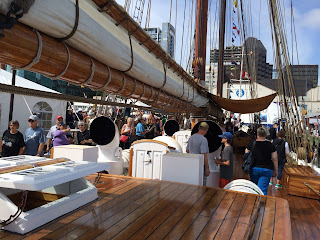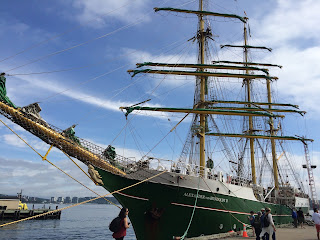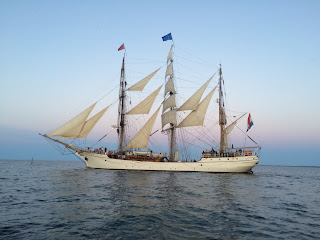One last word
before we move on from Summerside, P.E.I.: After we returned the rental car,
they were kind enough to drive us back to the marina. On our return, I realized
that I had plugged in my phone at the rental place, and forgot it there. We
entered the marina, and on learning what had happened, one of the restaurant
waitresses offered use of her car to retrieve the phone, saving me a 5
kilometre walk in 26ºC. So, kudos to the waitress at the Silver Fox Curling and
Yacht Club in Summerside, P.E.I.!
We left Summerside
in the morning with the primary goal of moving east and getting under the
Confederation Bridge that spans the Northumberland Straight and links P.E.I.
with New Brunswick. The wind was a bit
on the nose so we tacked several times and finally passed under around noon.
 |
| Approaching the Confederation Bridge |
We
maintained our course southeasterly with the wind favouring us, and made good
time under one of the best sails so far! We made our way towards Pugwash, Nova
Scotia, which looked to be a suitable anchorage for the night, considering forecasted
winds. We did not go to shore, but it looked like a wonderful cottaging area,
with a number of people swimming, playing on the beach and rock areas.
In the morning,
we set sail for the east, with the aim to see how far the wind would take us. It
was another hot day, so we are lucky to be out on the water! We saw a dolphin cross our bow! Winds were
light, but we made it to Tatamagouche Bay where we anchored again, without
going to shore. A few boaters came by to say hi. Tomorrow’s forecast is even
lighter winds.
Monday, July
17, 2017, we moved on again toward Pictou, but hoping we would get
further. We sailed along the coast,
enjoying the beautiful scenery that was going by… slowly… appreciating
everything, and doing our best to keep cool in the heatwave. Fog set in at noon. Not a thin veil, but a true East Coast “thick
as pea soup” kind of fog, that makes us thankful that we were prepared with AIS
and radar, and our chart plotter! We finally ended our day at the outside of
Merigomish Harbour at Calhoun Point, just as the fog was lifting.
And what a
beautiful sight! A 2-kilometre-long sand beach, and we anchored around a
protective rocky point. The beach, we later learned, is part of Melmerby Beach
Provincial Park, and is one of the warmest beaches north of Virginia on the
North American Atlantic coast! We rowed
into shore and picked a spot with few people to pull ashore. The water was shallow, and very warm.
 |
| Melmerby Beach, NS with Vata anchored nearby |
We had one of the most peaceful anchorages so
far at this spot, with no waves, no wind, and no noise – no halyards slapping
or ropes clanging inside the mast, and no waves lapping on the hull. Wonderful!
 |
| Dawn at Melmerby Beach |
The next
stretch of coastline toward the Straights of Canso has no harbours; no
anchorages; no places to hide in the event of bad weather, so after we checked
the forecast, we decided to motor to the next anchorage 41 nautical miles
distant. We saw a surprisingly high number
of dolphins as we passed Georgeville. Later that day, on July, 18, 2017, (day
67 after leaving the North Channel Yacht Club), we made it to Havre Boucher, at
the top of the Straight of Canso, where we tucked in for the night.
 |
| Houses and buildings onshore at Harvre Boucher, NS |
We had placed
an order for charts and Sailing Directions with Binnacle Marine a few weeks
ago, and the parcel was waiting for us in Port Hawkesbury!
 |
| The Canso Canal |
 |
| Highway/railway bridge opens to let us pass toward Port Hawkesbury |
 |
| Port Hawkesbury Marina |
We went into
Port Hawkesbury and topped up with diesel and water. The dockmaster at the marina
was very kind and allowed us to stay there while we went into town. He was
looking for a ride for us, when a man just sitting in his car at the dock
offered us a ride. It is always a surprise when people do nice things for
others! We will have much to pay forward.
We left the marina and anchored around the corner, but it was a noisy
night… train tracks along each shore of the bay, a busy street nearby, and of
course the port.
 |
| Trains moving around on both shores beside our anchorage at Port Hawkesbury |
In the morning,
we moved on through the Straights of Canso and into Chedabucto Bay on the way
to Canso.
 |
| Canso, NS |
It was a pretty town, but we
could not find a suitable anchorage, so we went into the next bay, Glasgow
Harbour, and found a very safe anchorage.
The windmills of Canso towered over us, while seals bobbed their heads
around us.
 |
| Canso Windmills seen from Glasgow Harbour |
The following
night we spent in Yankee Cove in Whitehead Harbour, slightly further south.
There was an aquaculture site there, but otherwise very desolate. Trees are
stunted and bud-wormed or over-mature and dying. This is a largely undeveloped wild coast, and it is thrilling to be discovering this area the way explorers always have - by sea! Fortunately we have modern technology, charts and Sailing Directions to assist us.
 |
| Shoreline at Yankee Cove |
The following
night we spent in Fisherman’s Harbour in Never Fail Cove. It was a nice protected
cove with a fishing fleet and dock. One
of the boats went out to take the grandchildren fishing and stopped by to chat.
The boat was called “I’se The Bye” (I’m not making this up) registered in Halifax,
and the grandkids were visiting from Waterloo, Ontario!
 |
| I'se the Bye from Fisherman's Harbour |
 |
| Fishing warf in Never Fail Cove, Fisherman's Harbour, NS |
From Fisherman’s
Harbour, we had a beautiful sail all day to Liscombe Harbour, where we made our
way up the river to Liscombe Resort and Conference Centre. We dinghied in and
met Chester, the head of the resort’s marine department. He has worked there for 40 years, and has
never been past Halifax. When we anchored
in the narrow river earlier, unbeknownst to us, he gave us advice on where to anchor,
and it turns out he is a licensed sea captain, tour guide and drives tourists
on a river tour to the Atlantic and knows this area like the back of his hand.
We held and our keel never touched bottom.
The resort is very nice, and has an excellent restaurant, pool,
whirlpool, sauna, and the main lobby is reminiscent of Bob Newhart’s Vermont
lodge in his old TV show!
 |
| Planked salmon being smoked for the Liscombe Lodge dinner |
 |
| The Reception at Liscombe Lodge |
































































